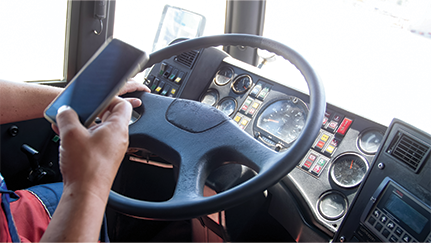Tech solutions help reduce phone-related distracted driving

Implementing a distracted driving policy is a critical step toward managing cell phone use of vehicle operators, addressing a leading cause of vehicle accidents. While having a distracted driving policy is a requirement, it DOES NOT guarantee your drivers will follow it. This is evident by the continual use of hand-held phones and texting in states that prohibit it.
A driver that knowingly violates their organization’s policy may negatively impact the organization’s defense in an accident, no matter who was at fault.
Many organizations are taking a proactive approach and are utilizing technological measures to control and monitor cell phone use. These solutions range from simple do-not-disturb-while-driving settings on a phone, to full software or telematics solutions that can lock down all phones or monitor phone use.
Let us look at key items to be considered when evaluating technological solutions to phone-related distracted driving.
Locking down a phone
Phone lockdown typically means restricting access to phone functions while driving. Exceptions may include:
- Handsfree calling
- Calls to/from designated numbers, like dispatchers or managers
- Access to GPS (Global Position System) routing app screens
- Music apps (if set up before driving or integrated with the vehicle’s system)
- Emergency 911 calls
Some solutions include:
- Tags or devices in the organization’s vehicle that link to the driver’s phone, triggering the lock-down. The phone functions normally in other vehicles.
- Limited functionality during specific hours or days. Useful for drivers using their own vehicles for business.
- Passenger indicator: Allows phone use when a passenger is present.
- Automated response: “I am driving now and will respond when safely parked.”
Phone use monitoring
Phone monitoring systems benefit organizations that allow phone calls while driving for critical purposes or hands-free calls. These systems:
- Detect Calls and Movement: They identify calls on the phone and track phone movement. The underlying idea is that any phone movement indicates distraction.
- Hands-Free Tracking: Some systems also monitor hands-free calls.
- Track Call Frequency and Duration: They track the number and duration of calls.
- Distracted Driving Score: Drivers receive scores based on call frequency, duration, and speed during calls.
- Management Portal: Managers evaluate staff phone use through a portal, including driver and team scores and trip maps.
- Post-Trip Feedback: Drivers receive feedback via the app, showing their distracted driving score and where phone use occurred during the route. Encourages safer habits!
Solutions
Organizations may use Do-Not-Disturb-While-Driving (DNDWD) features found in smart phones. They may also download an app with these features. For organizations that provide company phones, these apps are effective if the driver cannot disable them.
For organizations that do not provide phones, ensuring the DNDWD feature is enabled on an employee’s phone is difficult. Several major cell service providers allow lock-down administration of all phones that are part of a corporate account. An organization should contact their provider for specifics. Provider systems allow for easy administration and may be available as part of the service or at a very reasonable cost.
Enterprise Solutions
Enterprise solutions are available from a growing number of vendors. They allow an organization to lock down or monitor phone use of any phone in which the app is downloaded. Typically, a tag or other device is positioned in the vehicle which connects to the app so tracking only occurs when in an organization vehicle. Enterprise solutions provide the most features, settings, and flexibility. They can work with both company and employee-owned phones.
*Federal Motor Carrier Safety Regulations prohibit phone use other than hands-free calls for vehicles over 10,000 GVWR or GCWR. Locking down phones is strongly encouraged for drivers operating these regulated vehicles. *
References
National Safety Council, Technology can reduce cell phone distracted driving.

 >
>

 >
>
 >
>